Complete Solutions to MCQ (Level -II) of chapter ATOMS, MOLECULES AND NUCLEI of Class 12 book with complete answers and questions
| Class 12 | PHYSICS |
| Chapter | ATOMS, MOLECULES AND NUCLEI |
| MODERN PUBLICATION | MCQ (Level -II) |
| Number Of Questions | 77 |
| Academic Year | 2023-24 |
The ionisation potential of mercury is 10.39 volt. To gain energy sufficient enough to ionise mercury, an electron must travel in an electric field of `1.5 xx 10^6 Vm^(-1)` at distance of :
View SolutionThe ratio of longest wavelength and the shortest wavelength as observed in the five spectral series of emission spectrum of hydrogen is:
View SolutionThe Rydberg constant of `H_2` atom is 10967700 `m^(-1)`. Calculate the short and long wavelength limits in its Lyman series :
View SolutionFind the recoil speed of a hydrogen atom after it emits a photon in going from n= 5 state to n= 1 state `(R= 1.097 xx 10^7 m^(-1)):`
View SolutionThe hydrogen atom in the ground state excited by means of light of `lambda= 975 Å.` How many different hires are possible in resultant spectrum?
View SolutionIn above question, calculate the longest wavelength produced :
View SolutionEnergy levels A, B, C of a certain atom corresponding to increasing values of energy are `E_A lt E_(B) lt E_(C) lambda_(1),lambda_(2),lamda_(3)` are the corresponding wavelengths of the radiations corresponding to the transitions C to B, B to A and C to A respectively. Which of the following statements is true ?

View SolutionIf the speed of the electron in a hydrogen atom orbit of principal quantum number n be V, then the curve showing variation of V with n is:
View SolutionA hydrogen atom in the ground state absorbe 12.09 eV of energy. The change in the orbital angular momentum of the electron is:
View SolutionIf elements with principal quantum number n greater than four were not allowed in nature, then number of elements would be:
View SolutionIf 10% of a substance decays in 10 days, then approximate percentage of substance left after 24 days
View SolutionMean lives of a radioactive substance are 1620 and 405 years for `alpha and beta` -emission respectively. If `alpha and beta` decays are simultaneous, then time during which three fourth of the sample will decay is :
View SolutionA `U^(238)` preparation of mass 1 g emits `1.24 xx 10^(4) alpha` -particles per second. Find the half life of this nuclide and the activity of the preparation in becquerels:
View SolutionDetermine the age of an ancient wooden piece, if it is known that specific activity of `C^(14)` nuclide in it amounts to `3/5` of that in freshly fallen trees. The half life of `C^(14)` nuclide is 5570 yrs
View SolutionThe isotopes of `U^(238) and U^(235)` occur in nature in the ratio 128 : 1. Assuming that at time of earth's formation, they were equal in ratio, make an estimate of age of earth. The half lives of `U^(238) and U^(235)` are `4.5 xx 10^9 yrs and 7.13 xx 10^8` yrs respectively:
View SolutionUnder suitable conditions two a-particles can combine to produce a proton and a nuclide of `Li^(7).` What minimum K.E. must the `alpha` -particle have in order that the reaction, may proceed. The range of nuclear interaction is `10^(-14)m:`
View SolutionThe radioactivity of a sample is `R_1` at a time `t_1 and R_2` at time `t_2.` If half life of sample is T, then no. of atoms that have disintegrated in time `(t_2 - t_1)` is proportional
View SolutionAssuming that about 20 MeV of energy in released per fusion in the reaction
`""_(1)H^(2)+""_(1)H^(3) to ""_(0)n^(1)+ ""_(2)He^(4)`.
then the mass of `""_(1)H^(4)` consumes per day in a bowiem reactor of puwwer Imawat will styroximately be:
View SolutionThe intensity of `gamma-` rays falls to `1/8th` of its value after passing through 27 mm of lead toil. What should be thickness of the foil to reduce intensity of `gamma`- rays of its original value?
View SolutionThe half life of a cobalt radio istope is 5.3 years. What strength will a milli curic source of isotope have after a period of one year?
View SolutionSome amount of radioactive substance (half life =10 days) is spread inside a room and consequently the level of radiation becomes 50 times the permissible level for normal occupancy of the room. After how many days the room will be safe for occupation ?
View SolutionIf `lambda` is decay constant of a nucleus, find the probability that a nucleus will decay in time t and further will not decay in time t:
View SolutionTwo radioactive nuclei A and B have their disintegration constant `lambda_(A) and lambda_(B)` respectively. Initially `N_A and N_B` number of nuclei are taken, then the time after which their undisintegrated nuclei are same is :
View SolutionThe `K_alpha and K_(beta)` lines of characteristic X-ray spectrum of molybdenum are 0.76 Å and 0.64 Å respectively, The wavelength of La line is :
View SolutionThe dependence of binding energy per nucleon, `B_N` on the mass number, A is represented by
View SolutionA radioactive sample consists of two distinct species having equal number of atoms initially. The mean life time of one species is `tau` and that of the other is `5 tau`. The decay products in both cases are stable. A plot is made of the total number of radioactive nuclei as a function of time. Which of the following figures best represents the form of this plot.
View SolutionRadioactive element decays to form a stable nuclide, then the rate of decay of reactant `((dN)/(dt))` will vary with time (t) as shown in figure
View SolutionA radioactive sample has `N_(0)` active atoms at t=0. If the rate of disintegration at any time R and the number of atoms is N, then the ratio R/N varies with time as
View SolutionThe possible quantum numbers for 3d electrons are
View SolutionWhen the wave of hydrogen atom comes from infinity into the first orbit then the value of wave number is
View SolutionThe shortest wavelength in the Lyman series of hydrogen spectrum is 912 Å corresponding to a photon energy of 13.6 eV. The shortest wavelength in the Balmer series is about
View SolutionThe ratio of areas within the electron orbits for the first excited state to the ground state for hydrogen atom is
View SolutionEnergy of an etectron in och orbit of hydrogen atom is `k=(1)/(4pi epsi_(0))`
View SolutionThe energy of electron in the nth orbit of hydrogen atom is expressed as `E_m=(-13.6)/(n^(2)) eV.` The shortest and longest wavelength of Lyman series will be
View SolutionThe diagram shows the energy levels for an electron in a certain atom. Which transition shown represents the
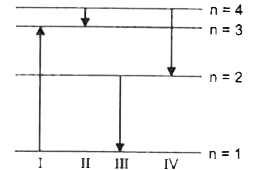
View SolutionAs the electrons in Bohr orbit of hydrogen atom passes from state n=2 to n=1, the kinetic energy K and potential energy U change as
View SolutionIn hydrogen atom, the electron is moving round the nucleus with velocity `2.18 xx 10^(6) m//s` is an orbit of radius of 0.528 Å. The acceleartion of the electron is
View SolutionThe ionization onergy of `Li^(++)` is equal to
View SolutionElectrons in a certain energy level `n =n_(1)`, can emit 3 spectral lines. When they are in another energy level, `n=n_2`. They can emit 6 spectral lines. The orbital speed of the electrons in the two orbits are in the ratio
View SolutionThe largest wavelength in the ultraviolet region of the hydrogen spectrum is 122 nm. The smallest wavelength in the infrared region of the hydrogen spectrum (to the nearest integer is)
View SolutionWhich of the following transition in Balmer series for hydrogen atom will have longest wavelength
View Solution`v_(1)` is the frequency of the series limit of Lyman series, `v_(2)` is the frequency of the first line of Lyman series and `v_(3)` is the frequency of the series limit of the Balmer series. Then
View SolutionThe number of electrons, neutrons and protons in a species are equal to 10,8 and 8 respectively. The proper symbol of the species is
View SolutionThe wavelength of the first spectral line in the Balmer series of hydrogen atom is 6561 Å. The wavelength of the second spectral line in the Balmer series of singly ionized helium atom is
View SolutionThe wavelength of the first line of Lyman series for hyrogen atom is equal to that of the second line of Balmer series for a hydrogen like ion. The atomic number Z of hydrogen like ion is
View SolutionElectron in hydrogen atom first jumps from third excited state to second excited state and then from second excited to the first excited state. The ratio of the wavelengths `lambda_(1), lambda_(2)` emitted in the two cases is
View SolutionHydrogen atom is excited from ground state to another state with principal quantum number equal to 4. Then the number of spectral lines in the emission will be
View SolutionA diatomic molecules is made of two masses `m_(2) and m_(2)` which are separated by a distance r. We calculate its rotational energy by applying Bohr's rule of angular momentum quantization, its energy will be given by (n is an integer)
View SolutionHydrogen atom from excited state comes to the ground state by emitting a photon of wavelength `lambda`. If R is the Rydberg cosntant, the principal quantum number n of the excited state is
View SolutionThe binding energies per nucleon for a deuteron and an `alpha` - particle are `x_(1) and x_(2)` respectively. What will be the energy Q released in the reaction, `""_(1)H^(2)+""_(1)H^(2) to ""_(2)He^(4)+Q`
View SolutionThe transition from the state n =4 to n =3 is a hydrogen like atom results is ultraviolet radiation. Infrared radiations will be obtained in the transition :
View SolutionThe intensity of X-rays from a coolidge tube is plotted against wavelength `lambda` as shown in the figure. The minimum wavelength found is `lambda_(c)` and the wavelength of the `K_(a)" line is "lambda_(k)`. As the accelerating voltage is increased.

View SolutionAn `H_2` atom and `Li^(++)` ion are both in the second excited state. If `l_(H) and l_(Li)` are their respective angular momemtum and `E_H and E_(Li)` are their energies then :
View SolutionIn the nuclear fusion reaction `""_(1)^(2)H+""_(1)^(3)H to ""_(2)^(4)He+n`
given that the repulsive potential energy between two nuclei is `-7.7 xx 10^(-14)J,` the temp. at which gases must be heated to initiate the reaction is nearly : `(k=1.38 xx 10^(-23))`
View SolutionThe binding energy of electron in a hydrogen atom is 13.6 eV, the energy required to remove the electron from the first excited state of `Li^(++)` is :
View SolutionWhen a `U^(238)` nucleus originally at rest decays by emitting an `alpha` -particle having a speed 'u', the recoil speed of the residual nucleus is :
View SolutionA radioactive sample at any instant has its disintegration rate 5000 disintegrations/minute. After 5 minutes, the rate is 1250 disintegrations/min. Then decay constant (per minute) is :
View SolutionThe electric potential between a proton and an electron is given by `V =V_0 In r/r_(0)" where "r_(0)` is a constant. Asuming Bohr'a model to be applicable, write variation of, `r_(n)` with n, n being the principal quantum number: --
View SolutionA nucleus disintegrates into two nuclear parts which have their velocities in the ratio 2:1. The ratio of their nuclear sizes will be :
View SolutionThe B.E. per nucleon of `""_(1)H^(2) and ""_(2)He^(4)` are 1.1 MeV and 7 MeV respectively. If two deuteron `(""_(1)H^(2))` nuclei react to form single helium nucleus, the energy released
View SolutionAn `alpha` -particle of energy 5 MeV is scattered through `180^@` by a fixed uranium nucleus. The distance of closest approach is of order:
View SolutionThe diagram shows the energy level of an electron in a certain atom. Which transition shown represents the emission of a photon with max. energy?
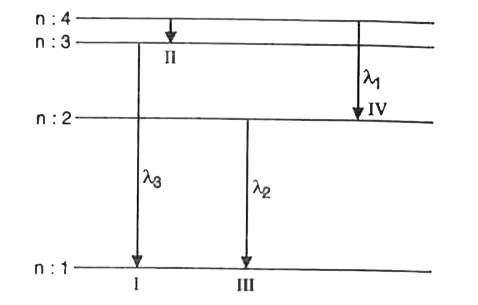
View SolutionThe intensity of `gamma-"rays"` from a given source is I. On passing through 36mm of lead, it is reduced to `I/8`. The thickness that will reduce the intensity to `I/2`, it
View SolutionHelium nuclei combine to form an oxygon nucleus. Calculate the binding energy per nucleon of oxygen nucleus, if `m_0=" 15.834 amu, "m_(He)= 4-0026 a.m.u. :`
View SolutionA p photon having 10.2 eV energy collides with a hydrogen atom in ground state inelastically. After few microseconds, one other photon having 15 eV collides with the same hydrogen atom, then a suitable detector can detect :
View SolutionAn `alpha`-particle of energy `1/2 mv^(2)` bombards a heavy nuclear target of charge Ze. Then distance of closest approach for a nucleus is proportional to :
View Solution`""_(87)^(221)Ra` undergoes radioactive decay with half life 4 days. What is the probablity that a nucleus undergoes decay in two half-lives:
View SolutionIf `M_(O)` is the mass of an oxygen isotope `""_(8)O^(17), M_(p) and M_(N)` are the masses of a proton and a neutron respectively, the nuclear binding energy of the isotope is:
View SolutionThe largest wavelength in the ultraviolet region of the hydrogen spectrum is 122 nm. The smallest wavelength in the infrared region of the hydrogen spectrum (to the nearest integer is)
View SolutionIn the options given below, let E denote the rest mass energy of a nucleus and n a neutron. The correct option is:
View SolutionSuppose an electron is attracted toward the origin by a force k/r where k is a constant and r is the distance of the electron from the origin. By applying Bohr model to this system, the radius of the nth orbital of the electron is found to be `r_(n)` and the kinetic energy of the electron to be `T_(n)`. Then which of the following is true?
View Solution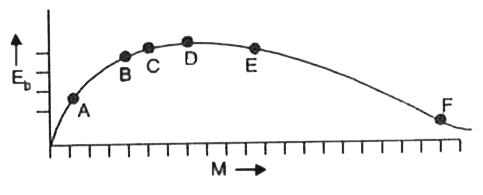
The above is a plot of binding energy per nucleon `E_(b)`, against the nuclear mass M, A,B,C,D,E,F correspond to different nuclei. Consider four reactions:
(i) `A+B to C+e` (ii) `C to A+B+epsi`
(iii) `D+E to F+epsi and` (iv) `F to D+E+epsi`
where `epsi` is the energy released? In which reaction is `epsi` positive?
View SolutionA radioactive nucleus (initial mass number A and atomic number Z) emits 3 `alpha` -particles and 2 positrons. The ratio of number of neutrons to that of protons in the final nucleus will be:
View SolutionAssume that the nuclear binding energy per nucleon (BIA) versus mass number (A) is as shown in the figure. Use this plot to choose the correct choice(s) given below:
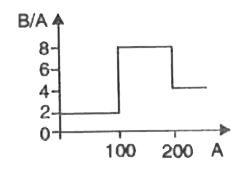
View SolutionAssume that two deuteron nuclei in the core of fusion reactor at temperature T are moving towards each other, each with kinetic energy 1.5 KT, when the separation between them is large enough to neglect Coulomb potential energy. Also neglect any interaction from other particles in the core. The minimum temperature T required for them to reach a separation of `4 xx 10^(-15)` m is in the range.
View SolutionResults of calculations for four difforent designs of a fusion reactor using D-D reaction are given below. Which of these is most promising based on Lawson criterion ?
View SolutionTo determine the half life of a radioactive element, a student plots a graph of In `|(dN(t))/(dt)|` versus t. Here `(dN(t))/(dt)` is the rate of radioactive decay at time t.
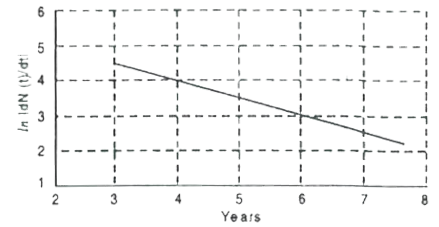
If the number of radioactive nuclei of this element decreases by a factor of p after 4.16 years. the value of p is...........
View Solution
MCQ (Level -II) questions and complete solutions for chapter ATOMS, MOLECULES AND NUCLEI of MODERN PUBLICATION PHYSICS (KANNADA ENGLISH) of Class 12